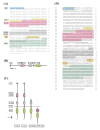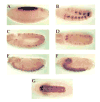Identification and characterization of DAlk: a novel Drosophila melanogaster RTK which drives ERK activation in vivo
- PMID: 11442633
- PMCID: PMC1975818
- DOI: 10.1046/j.1365-2443.2001.00440.x
Identification and characterization of DAlk: a novel Drosophila melanogaster RTK which drives ERK activation in vivo
Abstract
Background: The mammalian receptor protein tyrosine kinase (RTK), Anaplastic Lymphoma Kinase (ALK), was first described as the product of the t(2;5) chromosomal translocation found in non-Hodgkin's lymphoma. While the mechanism of ALK activation in non-Hodgkin's lymphoma has been examined, to date, no in vivo role for this orphan insulin receptor family RTK has been described.
Results: We describe here a novel Drosophila melanogaster RTK, DAlk, which we have mapped to band 53 on the right arm of the second chromosome. Full-length DAlk cDNA encodes a phosphoprotein of 200 kDa, which shares homology not only with mammalian ALK but also with the orphan RTK LTK. Analysis of both mammalian and Drosophila ALK reveals that the ALK family of RTKs contains a newly identified MAM domain within their extracellular domains. Like its mammalian counterpart, DAlk appears to be expressed in the developing CNS by in situ analysis. However, in addition to expression of DAlk in the Drosophila brain, careful analysis reveals an additional early role for DAlk in the developing visceral mesoderm where its expression is coincident with activated ERK.
Conclusion: In this paper we describe a Drosophila melanogaster Alk RTK which is expressed in the developing embryonic mesoderm and CNS. Our data provide evidence for the existence of a DAlk RTK pathway in Drosophila. We show that ERK participates in this pathway, and that it is activated by DAlk in vivo. Expression patterns of dALK, together with activated ERK, suggest that DAlk fulfils the criteria of the missing RTK pathway, leading to ERK activation in the developing visceral mesoderm.
Figures







Similar articles
-
A crucial role for the Anaplastic lymphoma kinase receptor tyrosine kinase in gut development in Drosophila melanogaster.EMBO Rep. 2003 Aug;4(8):781-6. doi: 10.1038/sj.embor.embor897. Epub 2003 Jul 4. EMBO Rep. 2003. PMID: 12855999 Free PMC article.
-
The ligand Jelly Belly (Jeb) activates the Drosophila Alk RTK to drive PC12 cell differentiation, but is unable to activate the mouse ALK RTK.J Exp Zool B Mol Dev Evol. 2007 May 15;308(3):269-82. doi: 10.1002/jez.b.21146. J Exp Zool B Mol Dev Evol. 2007. PMID: 17285636
-
Jeb signals through the Alk receptor tyrosine kinase to drive visceral muscle fusion.Nature. 2003 Oct 2;425(6957):512-6. doi: 10.1038/nature01950. Nature. 2003. PMID: 14523447
-
Pathobiology of NPM-ALK and variant fusion genes in anaplastic large cell lymphoma and other lymphomas.Leukemia. 2000 Sep;14(9):1533-59. doi: 10.1038/sj.leu.2401878. Leukemia. 2000. PMID: 10994999 Review.
-
Anaplastic lymphoma kinase: "Ligand Independent Activation" mediated by the PTN/RPTPβ/ζ signaling pathway.Biochim Biophys Acta. 2013 Oct;1834(10):2219-23. doi: 10.1016/j.bbapap.2013.06.004. Epub 2013 Jun 15. Biochim Biophys Acta. 2013. PMID: 23777859 Review.
Cited by
-
Octopamine-mediated circuit mechanism underlying controlled appetite for palatable food in Drosophila.Proc Natl Acad Sci U S A. 2013 Sep 17;110(38):15431-6. doi: 10.1073/pnas.1308816110. Epub 2013 Sep 3. Proc Natl Acad Sci U S A. 2013. PMID: 24003139 Free PMC article.
-
The neuronal receptor tyrosine kinase Alk is a target for longevity.Aging Cell. 2020 May;19(5):e13137. doi: 10.1111/acel.13137. Epub 2020 Apr 15. Aging Cell. 2020. PMID: 32291952 Free PMC article.
-
A directed screen for genes involved in Drosophila blood cell activation.Proc Natl Acad Sci U S A. 2004 Sep 28;101(39):14192-7. doi: 10.1073/pnas.0403789101. Epub 2004 Sep 20. Proc Natl Acad Sci U S A. 2004. PMID: 15381778 Free PMC article.
-
A crucial role for the Anaplastic lymphoma kinase receptor tyrosine kinase in gut development in Drosophila melanogaster.EMBO Rep. 2003 Aug;4(8):781-6. doi: 10.1038/sj.embor.embor897. Epub 2003 Jul 4. EMBO Rep. 2003. PMID: 12855999 Free PMC article.
-
Mechanistic insight into ALK receptor tyrosine kinase in human cancer biology.Nat Rev Cancer. 2013 Oct;13(10):685-700. doi: 10.1038/nrc3580. Nat Rev Cancer. 2013. PMID: 24060861 Review.
References
-
- Adams MD, Celniker SE, Holt RA, et al. The genome sequence of Drosophila melanogaster. Science. 2000;287:2185–2195. - PubMed
-
- Altschul SF, Gish W, Miller W, Myers EW, Lipman DJ. Basic local alignment search tool. J Mol Biol. 1990;215:403–410. - PubMed
-
- Beckmann G, Bork P. An adhesive domain detected in functionally diverse receptors. Trends Biochem Sci. 1993;18:40– 41. - PubMed
-
- Beiman M, Shilo BZ, Volk T. Heartless, a Drosophila FGF receptor homolog, is essential for cell migration and establishment of several mesodermal lineages. Genes Dev. 1996;10:2993–3002. - PubMed
-
- Bourgouin C, Lundgren SE, Thomas JB. Apterous is a Drosophila LIM domain gene required for the development of a subset of embryonic muscles. Neuron. 1992;9:549–561. - PubMed
Publication types
MeSH terms
Substances
Grants and funding
LinkOut - more resources
Full Text Sources
Other Literature Sources
Molecular Biology Databases
Miscellaneous

